Critically Evaluating HMC's China Market Expansion Strategy
VerifiedAdded on 2022/09/11
|6
|1386
|28
Case Study
AI Summary
The assignment critically evaluates Hyundai Motor Company's (HMC) strategic decision to enter the Chinese market through a joint venture with Beijing Automotive Industry Holding Corp. (BAIC). The study explores HMC's motives, including the burgeoning demand for automobiles, the advantages of a low-cost manufacturing base, and the need to navigate China's strict commercial laws. The analysis highlights the benefits of joint ventures, such as access to land, licenses, distribution channels, and government support. The paper examines how HMC leveraged its 'quality management' to attract Chinese consumers and improve brand recognition, which was crucial in a market where brand image heavily influenced consumer behavior. The case study further discusses the importance of distribution channels, the role of the Chinese partner (BAIC), and the building of a successful production system. The expansion and joint venture in China proved successful for HMC, providing access to the Chinese customer base and overcoming the challenges of market entry and competition. The company's ability to use their existing network in the global suppliers in Korea also added to their success.
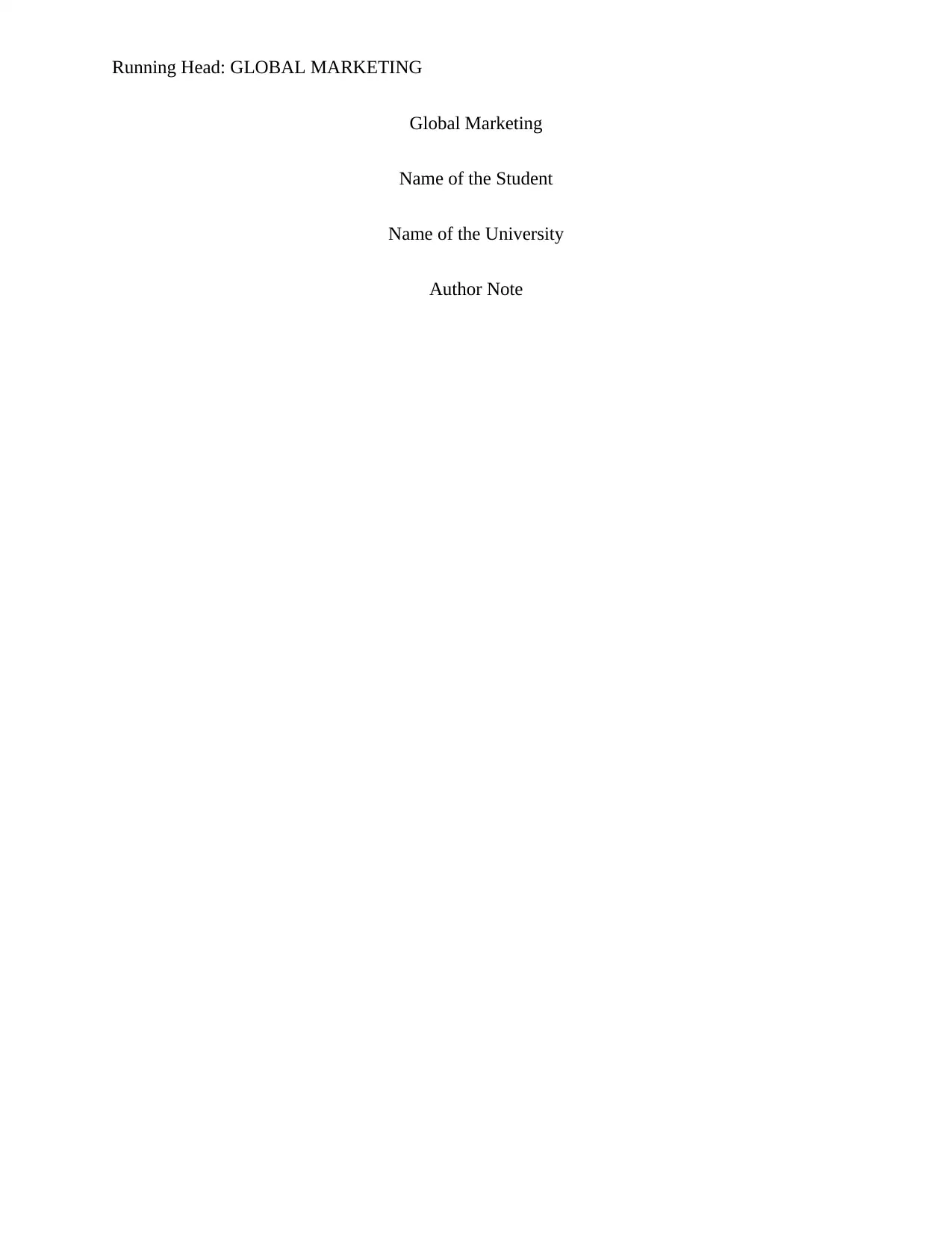
Running Head: GLOBAL MARKETING
Global Marketing
Name of the Student
Name of the University
Author Note
Global Marketing
Name of the Student
Name of the University
Author Note
Paraphrase This Document
Need a fresh take? Get an instant paraphrase of this document with our AI Paraphraser
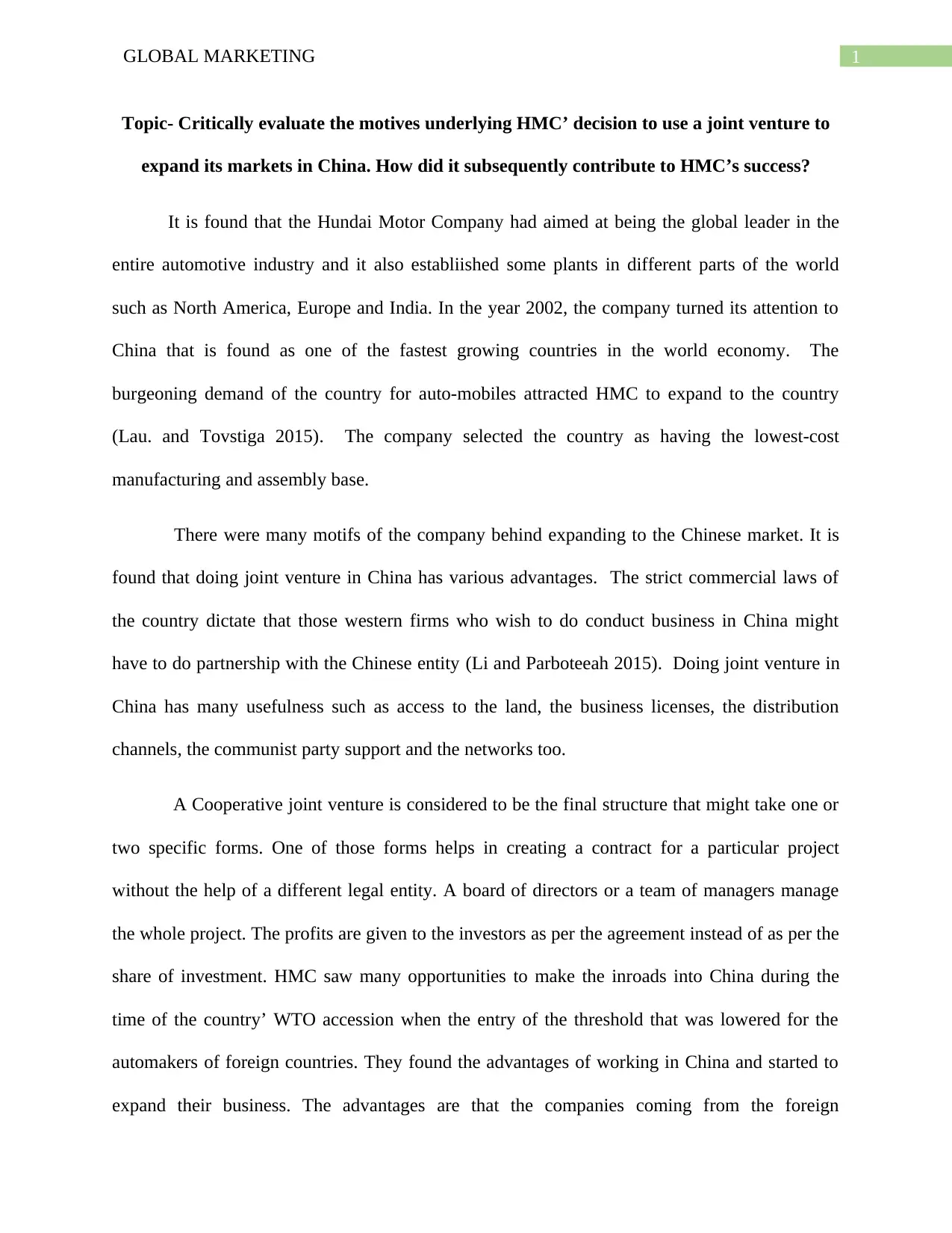
1GLOBAL MARKETING
Topic- Critically evaluate the motives underlying HMC’ decision to use a joint venture to
expand its markets in China. How did it subsequently contribute to HMC’s success?
It is found that the Hundai Motor Company had aimed at being the global leader in the
entire automotive industry and it also establiished some plants in different parts of the world
such as North America, Europe and India. In the year 2002, the company turned its attention to
China that is found as one of the fastest growing countries in the world economy. The
burgeoning demand of the country for auto-mobiles attracted HMC to expand to the country
(Lau. and Tovstiga 2015). The company selected the country as having the lowest-cost
manufacturing and assembly base.
There were many motifs of the company behind expanding to the Chinese market. It is
found that doing joint venture in China has various advantages. The strict commercial laws of
the country dictate that those western firms who wish to do conduct business in China might
have to do partnership with the Chinese entity (Li and Parboteeah 2015). Doing joint venture in
China has many usefulness such as access to the land, the business licenses, the distribution
channels, the communist party support and the networks too.
A Cooperative joint venture is considered to be the final structure that might take one or
two specific forms. One of those forms helps in creating a contract for a particular project
without the help of a different legal entity. A board of directors or a team of managers manage
the whole project. The profits are given to the investors as per the agreement instead of as per the
share of investment. HMC saw many opportunities to make the inroads into China during the
time of the country’ WTO accession when the entry of the threshold that was lowered for the
automakers of foreign countries. They found the advantages of working in China and started to
expand their business. The advantages are that the companies coming from the foreign
Topic- Critically evaluate the motives underlying HMC’ decision to use a joint venture to
expand its markets in China. How did it subsequently contribute to HMC’s success?
It is found that the Hundai Motor Company had aimed at being the global leader in the
entire automotive industry and it also establiished some plants in different parts of the world
such as North America, Europe and India. In the year 2002, the company turned its attention to
China that is found as one of the fastest growing countries in the world economy. The
burgeoning demand of the country for auto-mobiles attracted HMC to expand to the country
(Lau. and Tovstiga 2015). The company selected the country as having the lowest-cost
manufacturing and assembly base.
There were many motifs of the company behind expanding to the Chinese market. It is
found that doing joint venture in China has various advantages. The strict commercial laws of
the country dictate that those western firms who wish to do conduct business in China might
have to do partnership with the Chinese entity (Li and Parboteeah 2015). Doing joint venture in
China has many usefulness such as access to the land, the business licenses, the distribution
channels, the communist party support and the networks too.
A Cooperative joint venture is considered to be the final structure that might take one or
two specific forms. One of those forms helps in creating a contract for a particular project
without the help of a different legal entity. A board of directors or a team of managers manage
the whole project. The profits are given to the investors as per the agreement instead of as per the
share of investment. HMC saw many opportunities to make the inroads into China during the
time of the country’ WTO accession when the entry of the threshold that was lowered for the
automakers of foreign countries. They found the advantages of working in China and started to
expand their business. The advantages are that the companies coming from the foreign
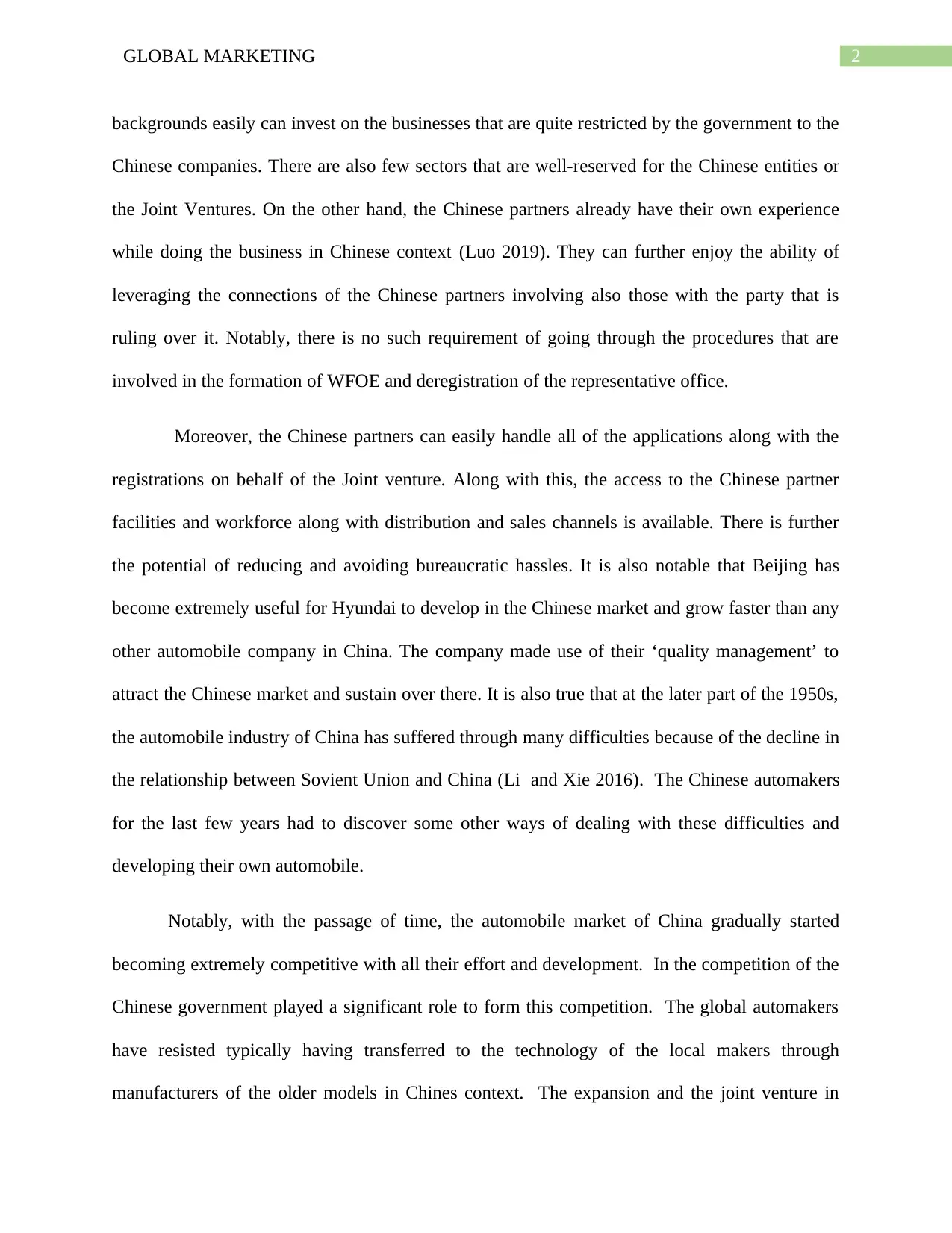
2GLOBAL MARKETING
backgrounds easily can invest on the businesses that are quite restricted by the government to the
Chinese companies. There are also few sectors that are well-reserved for the Chinese entities or
the Joint Ventures. On the other hand, the Chinese partners already have their own experience
while doing the business in Chinese context (Luo 2019). They can further enjoy the ability of
leveraging the connections of the Chinese partners involving also those with the party that is
ruling over it. Notably, there is no such requirement of going through the procedures that are
involved in the formation of WFOE and deregistration of the representative office.
Moreover, the Chinese partners can easily handle all of the applications along with the
registrations on behalf of the Joint venture. Along with this, the access to the Chinese partner
facilities and workforce along with distribution and sales channels is available. There is further
the potential of reducing and avoiding bureaucratic hassles. It is also notable that Beijing has
become extremely useful for Hyundai to develop in the Chinese market and grow faster than any
other automobile company in China. The company made use of their ‘quality management’ to
attract the Chinese market and sustain over there. It is also true that at the later part of the 1950s,
the automobile industry of China has suffered through many difficulties because of the decline in
the relationship between Sovient Union and China (Li and Xie 2016). The Chinese automakers
for the last few years had to discover some other ways of dealing with these difficulties and
developing their own automobile.
Notably, with the passage of time, the automobile market of China gradually started
becoming extremely competitive with all their effort and development. In the competition of the
Chinese government played a significant role to form this competition. The global automakers
have resisted typically having transferred to the technology of the local makers through
manufacturers of the older models in Chines context. The expansion and the joint venture in
backgrounds easily can invest on the businesses that are quite restricted by the government to the
Chinese companies. There are also few sectors that are well-reserved for the Chinese entities or
the Joint Ventures. On the other hand, the Chinese partners already have their own experience
while doing the business in Chinese context (Luo 2019). They can further enjoy the ability of
leveraging the connections of the Chinese partners involving also those with the party that is
ruling over it. Notably, there is no such requirement of going through the procedures that are
involved in the formation of WFOE and deregistration of the representative office.
Moreover, the Chinese partners can easily handle all of the applications along with the
registrations on behalf of the Joint venture. Along with this, the access to the Chinese partner
facilities and workforce along with distribution and sales channels is available. There is further
the potential of reducing and avoiding bureaucratic hassles. It is also notable that Beijing has
become extremely useful for Hyundai to develop in the Chinese market and grow faster than any
other automobile company in China. The company made use of their ‘quality management’ to
attract the Chinese market and sustain over there. It is also true that at the later part of the 1950s,
the automobile industry of China has suffered through many difficulties because of the decline in
the relationship between Sovient Union and China (Li and Xie 2016). The Chinese automakers
for the last few years had to discover some other ways of dealing with these difficulties and
developing their own automobile.
Notably, with the passage of time, the automobile market of China gradually started
becoming extremely competitive with all their effort and development. In the competition of the
Chinese government played a significant role to form this competition. The global automakers
have resisted typically having transferred to the technology of the local makers through
manufacturers of the older models in Chines context. The expansion and the joint venture in
⊘ This is a preview!⊘
Do you want full access?
Subscribe today to unlock all pages.

Trusted by 1+ million students worldwide
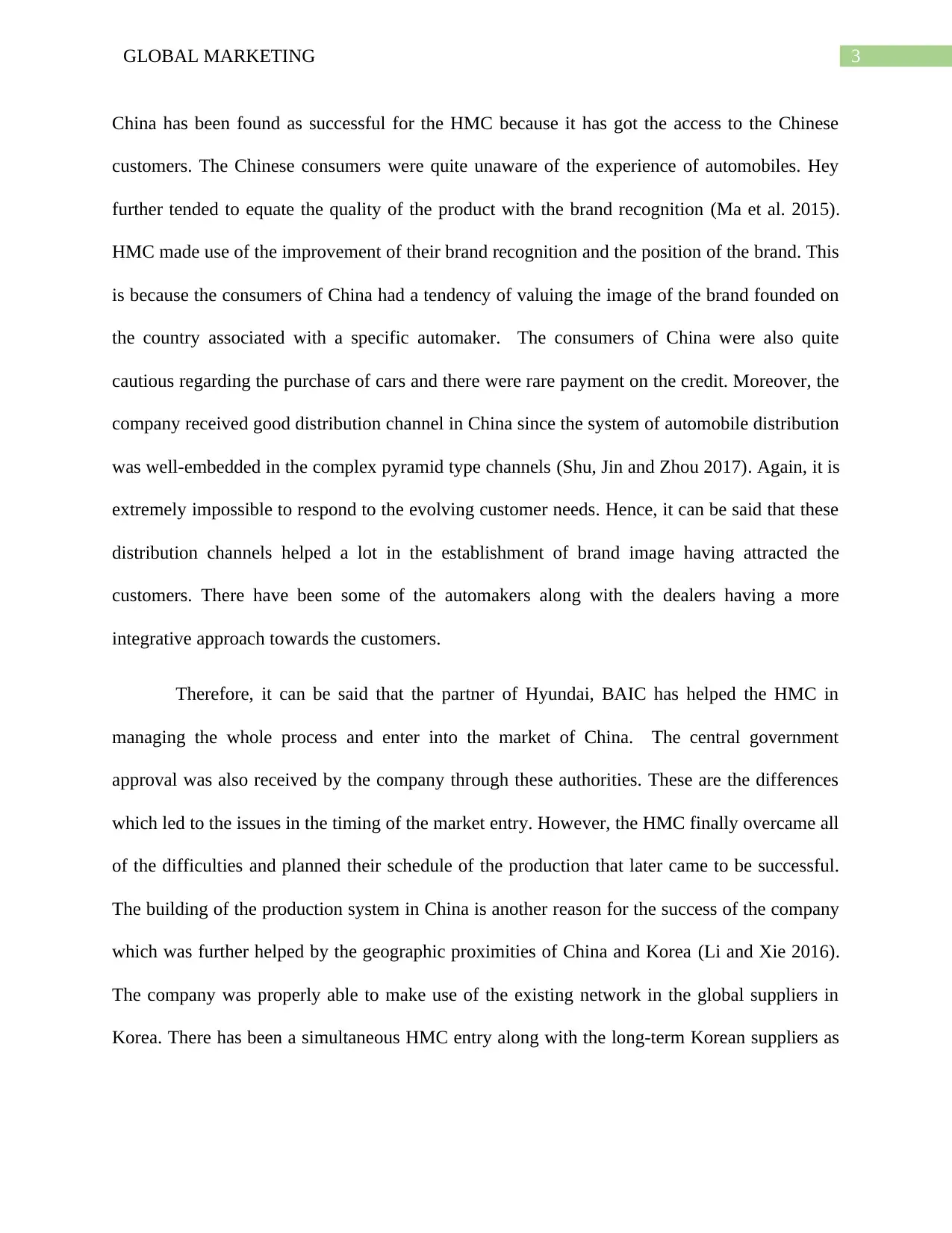
3GLOBAL MARKETING
China has been found as successful for the HMC because it has got the access to the Chinese
customers. The Chinese consumers were quite unaware of the experience of automobiles. Hey
further tended to equate the quality of the product with the brand recognition (Ma et al. 2015).
HMC made use of the improvement of their brand recognition and the position of the brand. This
is because the consumers of China had a tendency of valuing the image of the brand founded on
the country associated with a specific automaker. The consumers of China were also quite
cautious regarding the purchase of cars and there were rare payment on the credit. Moreover, the
company received good distribution channel in China since the system of automobile distribution
was well-embedded in the complex pyramid type channels (Shu, Jin and Zhou 2017). Again, it is
extremely impossible to respond to the evolving customer needs. Hence, it can be said that these
distribution channels helped a lot in the establishment of brand image having attracted the
customers. There have been some of the automakers along with the dealers having a more
integrative approach towards the customers.
Therefore, it can be said that the partner of Hyundai, BAIC has helped the HMC in
managing the whole process and enter into the market of China. The central government
approval was also received by the company through these authorities. These are the differences
which led to the issues in the timing of the market entry. However, the HMC finally overcame all
of the difficulties and planned their schedule of the production that later came to be successful.
The building of the production system in China is another reason for the success of the company
which was further helped by the geographic proximities of China and Korea (Li and Xie 2016).
The company was properly able to make use of the existing network in the global suppliers in
Korea. There has been a simultaneous HMC entry along with the long-term Korean suppliers as
China has been found as successful for the HMC because it has got the access to the Chinese
customers. The Chinese consumers were quite unaware of the experience of automobiles. Hey
further tended to equate the quality of the product with the brand recognition (Ma et al. 2015).
HMC made use of the improvement of their brand recognition and the position of the brand. This
is because the consumers of China had a tendency of valuing the image of the brand founded on
the country associated with a specific automaker. The consumers of China were also quite
cautious regarding the purchase of cars and there were rare payment on the credit. Moreover, the
company received good distribution channel in China since the system of automobile distribution
was well-embedded in the complex pyramid type channels (Shu, Jin and Zhou 2017). Again, it is
extremely impossible to respond to the evolving customer needs. Hence, it can be said that these
distribution channels helped a lot in the establishment of brand image having attracted the
customers. There have been some of the automakers along with the dealers having a more
integrative approach towards the customers.
Therefore, it can be said that the partner of Hyundai, BAIC has helped the HMC in
managing the whole process and enter into the market of China. The central government
approval was also received by the company through these authorities. These are the differences
which led to the issues in the timing of the market entry. However, the HMC finally overcame all
of the difficulties and planned their schedule of the production that later came to be successful.
The building of the production system in China is another reason for the success of the company
which was further helped by the geographic proximities of China and Korea (Li and Xie 2016).
The company was properly able to make use of the existing network in the global suppliers in
Korea. There has been a simultaneous HMC entry along with the long-term Korean suppliers as
Paraphrase This Document
Need a fresh take? Get an instant paraphrase of this document with our AI Paraphraser

4GLOBAL MARKETING
the Hyundai Mobis into market of China that was made possible because of the reduction in
costs and improvement of quality.
the Hyundai Mobis into market of China that was made possible because of the reduction in
costs and improvement of quality.
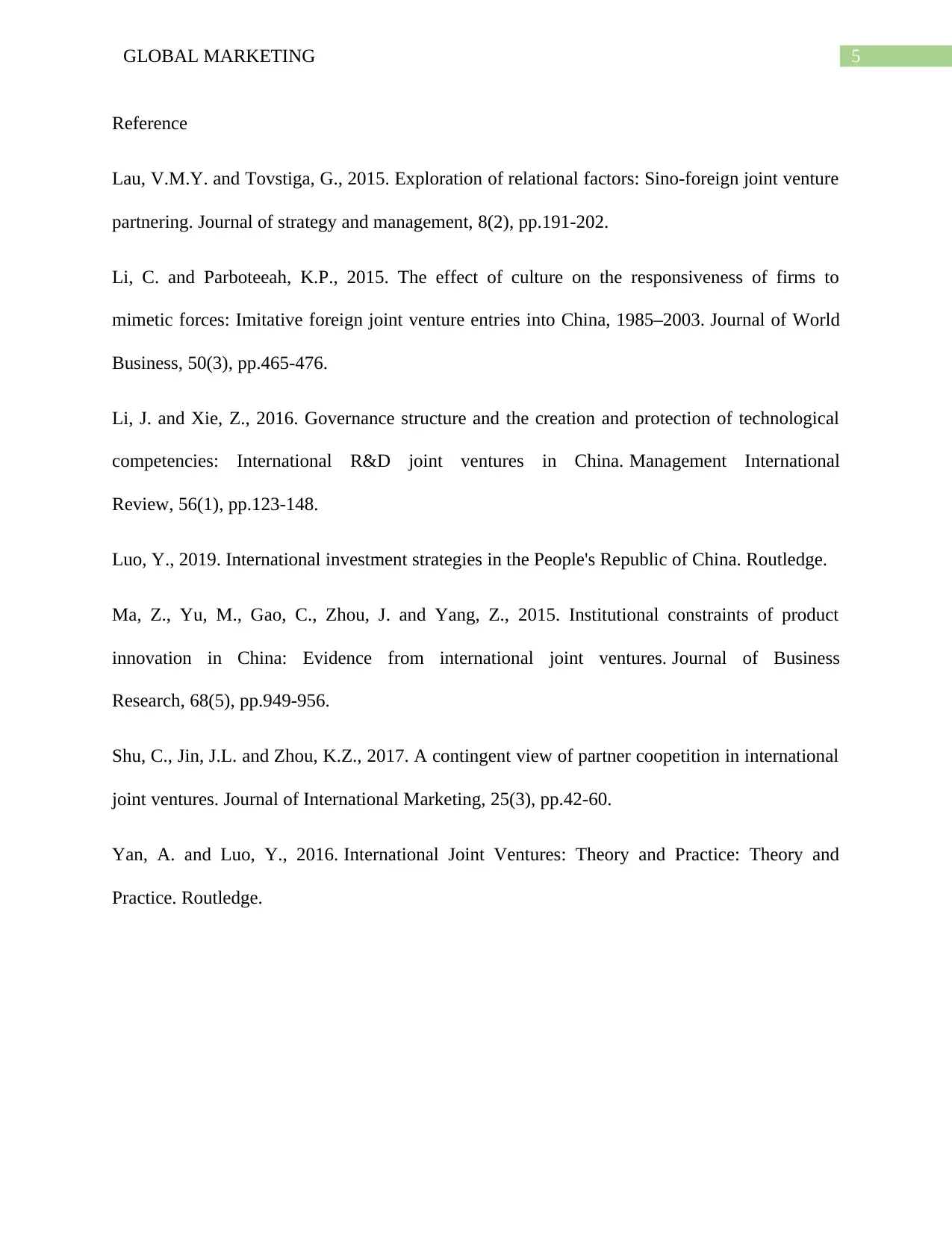
5GLOBAL MARKETING
Reference
Lau, V.M.Y. and Tovstiga, G., 2015. Exploration of relational factors: Sino-foreign joint venture
partnering. Journal of strategy and management, 8(2), pp.191-202.
Li, C. and Parboteeah, K.P., 2015. The effect of culture on the responsiveness of firms to
mimetic forces: Imitative foreign joint venture entries into China, 1985–2003. Journal of World
Business, 50(3), pp.465-476.
Li, J. and Xie, Z., 2016. Governance structure and the creation and protection of technological
competencies: International R&D joint ventures in China. Management International
Review, 56(1), pp.123-148.
Luo, Y., 2019. International investment strategies in the People's Republic of China. Routledge.
Ma, Z., Yu, M., Gao, C., Zhou, J. and Yang, Z., 2015. Institutional constraints of product
innovation in China: Evidence from international joint ventures. Journal of Business
Research, 68(5), pp.949-956.
Shu, C., Jin, J.L. and Zhou, K.Z., 2017. A contingent view of partner coopetition in international
joint ventures. Journal of International Marketing, 25(3), pp.42-60.
Yan, A. and Luo, Y., 2016. International Joint Ventures: Theory and Practice: Theory and
Practice. Routledge.
Reference
Lau, V.M.Y. and Tovstiga, G., 2015. Exploration of relational factors: Sino-foreign joint venture
partnering. Journal of strategy and management, 8(2), pp.191-202.
Li, C. and Parboteeah, K.P., 2015. The effect of culture on the responsiveness of firms to
mimetic forces: Imitative foreign joint venture entries into China, 1985–2003. Journal of World
Business, 50(3), pp.465-476.
Li, J. and Xie, Z., 2016. Governance structure and the creation and protection of technological
competencies: International R&D joint ventures in China. Management International
Review, 56(1), pp.123-148.
Luo, Y., 2019. International investment strategies in the People's Republic of China. Routledge.
Ma, Z., Yu, M., Gao, C., Zhou, J. and Yang, Z., 2015. Institutional constraints of product
innovation in China: Evidence from international joint ventures. Journal of Business
Research, 68(5), pp.949-956.
Shu, C., Jin, J.L. and Zhou, K.Z., 2017. A contingent view of partner coopetition in international
joint ventures. Journal of International Marketing, 25(3), pp.42-60.
Yan, A. and Luo, Y., 2016. International Joint Ventures: Theory and Practice: Theory and
Practice. Routledge.
⊘ This is a preview!⊘
Do you want full access?
Subscribe today to unlock all pages.

Trusted by 1+ million students worldwide
1 out of 6
Related Documents
Your All-in-One AI-Powered Toolkit for Academic Success.
+13062052269
info@desklib.com
Available 24*7 on WhatsApp / Email
![[object Object]](/_next/static/media/star-bottom.7253800d.svg)
Unlock your academic potential
Copyright © 2020–2025 A2Z Services. All Rights Reserved. Developed and managed by ZUCOL.





